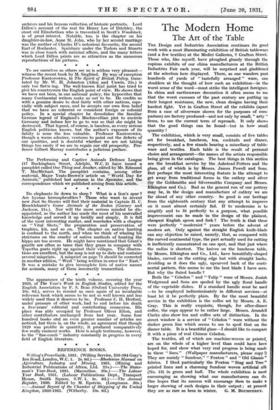The Modern Home
The Art of the Table
Pun Design and Industries Association continues its good work with a most illuminating exhibition of British tableware (and a few textiles) at the Medici Galleries, 7 Grafton Street.
Those who, like myself, have ploughed glumly through the copious exhibits of our china manufacturers at the British Industries Fair each year, will be surprised and gladdened at the selection here displayed. There, as one wanders past hundreds of yards of " tastefully arranged " ware, one shudders at the thought of how such an exhibition—in the worst sense of the word—must strike the intelligent foreigner. In china and earthenware decoration it often seems to me that the worst excesses of the past century are putting up their longest resistance, the new, clean designs having their hardest fight. Yet in Grafton Street all the exhibits (apart from a case of silverware shown for the purposes of com- parison) are factory produced—and not only by small, " arty " firms, to use the current term of reproach. It only shows that the good things can be found—but in how small quantity !
The exhibition, which is very small, consists of five tables set for breakfast, luncheon, tea, cocktails and dinner, respectively, and a few stands bearing a miscellany of table-
ware and textiles. Each table is the result of personal• choice and arrangement—the names of the artists responsible
being-given in the catalogue. The best things in this section are the breakfast service by the Ashstead Potters and the glass, all of which is by Messrs. James Powell and Sons. But perhaps the most interesting feature is the attempt to get away from traditional forms in the cutlery and silver
(by the Goldsmiths and Silversmiths Company And Messrs. Elkington and Co.). Bad as the general run of our pottery may be, in the design and manufacture of cutlery we are -far ahead of any other country. So good is our heritage from the eighteenth century that any attempt to improve
on it must almost certainly fail. If to modernize is to
simplify and to fit perfectly to a _purpose, what possible improvement can be made in the design of the plainest, cheapest English_ spoon_ and fork ? ..The truth is that these
were perfectly " modernist" years before the advent of
modern art.. Only against the straight English knife-blade can any objection be raised, namely, that, as compared with
• the curved continental type, the part actually used for cutting _ is inefficiently. concentrated on one spot, and that just where the radius is shortest. The knives on the luncheon table,
by Messrs. Elkington and Co., Ltd., have beautifully-shaped blades, curved on the cutting edge but with straight backs. Avoiding as it does the ugly, upcurved back of the conti- nental pattern, this seems to me the best blade I have seen. But why the fluted handle ?
Both the " Celadon " and " Tulip " ware of Messrs. Josiah Wedgwood and Sons are spoiled by the ugly floral handle of the vegetable dishes. If a standard handle must be used —to be employed indiscriminately in different services—at least let it be perfectly plain. By far the- most beautiful service in the exhibition is the coffee set by Messrs. A. E.
Gray. This is really exquisite, though, for after-dinner coffee, the cups appear to be rather large. Messrs. Arundell Clarke also show tea and coffee sets of distinction. In the street window is a service of " Celadon " ware without the darker green line which seems to me to spoil that on the dinner table. It is a beautiful glaze—I should like to compare it with a piece of real Chinese Celadon.
The textiles, all of which are machine-woven or printed, are on the whole. of a higher level than could have been hoped for, and show what very real progress is being made in these " lines." (Wallpaper manufacturers, please copy !) They are mainly " Sundour," " Foxton " and " Old Glamis " fabrics. I liked particularly the Foxton " Stag and Tree " printed linen and a charming Sundour woven artificial silk (No. 13) in green and buff. The whole exhibition is most encouraging as showing what our manufacturers can do. One hopes that its success will encourage them to make a larger showing of such designs in their output ; at present they are as rare as bees in winter. G. M. Bouxemmir.










































 Previous page
Previous page